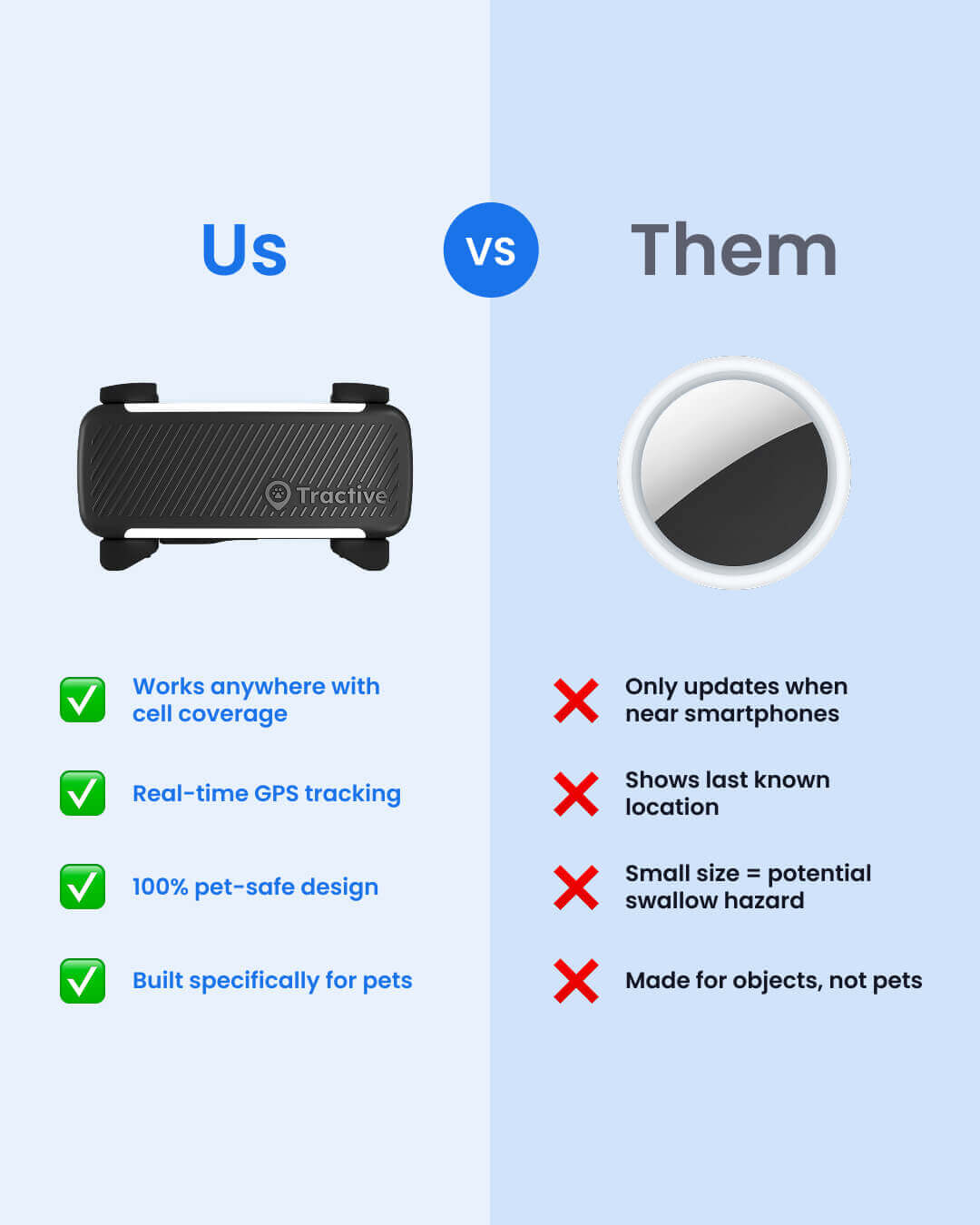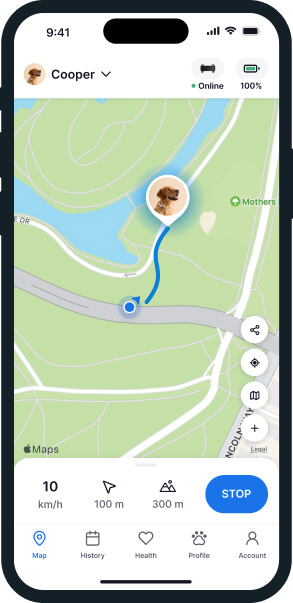Why Using AirTag For Dogs Is A Bad Idea
AirTags are popular, but they’re not really suitable for our furry friends. Learn why a GPS dog tracker is the smarter and safer choice for dog parents everywhere.
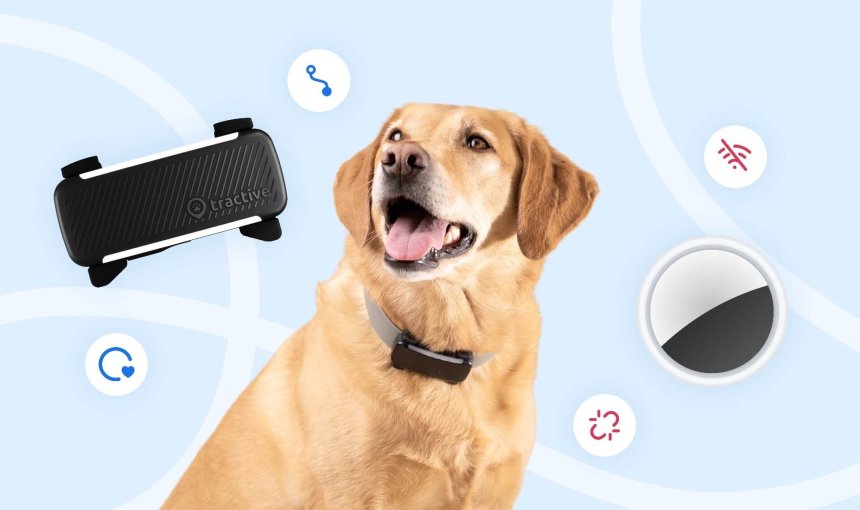
Key Takeaways: AirTag for dogs vs GPS dog tracker
AirTag for dogs
- ❌ Limited range: AirTag only works when an Apple device is nearby — no tracking if your pet is out of range.
- ❌ No live tracking: AirTag only shows the last known location
- ❌ No escape alerts if your pet runs off.
- ❌ No built-in activity or health tracking features.
- ❌ Choke & swallow hazard: AirTag can be dangerous if chewed or swallowed.
Tractive GPS dog tracker
- ✅ Unlimited range worldwide via cell coverage.
- ✅ Real-time GPS tracking with updates every 2-3 seconds.
- ✅ Instant escape alerts if your dog leaves a safe zone.
- ✅ Built-in activity & health tracking.
- ✅ Waterproof & durable for adventurous dogs.

Always know your buddy is healthy & safe
Read more- What is Apple AirTag?
- Why AirTag is perfect for finding lost items
- …but you can’t rely on it to track a runaway dog
- Track your dog with confidence—beyond Bluetooth
- The problems with using AirTag for dog tracking
- What is a GPS dog tracker ?
- Top reasons to choose a GPS dog tracker like Tractive over AirTag for do gs
- Real Stories: Why dog parents switch from AirTag to Tractive GPS
- The right dog tracker can save your dog’s life
- The bottom line on using AirTags for dogs
- FAQs: AirTag for dogs
What is Apple AirTag?
Apple AirTag is a tiny item-tracking device designed to help users keep track of personal items like bags, wallets or keys. Attach an AirTag to any item you want to track and view its location in Apple’s Find My app.
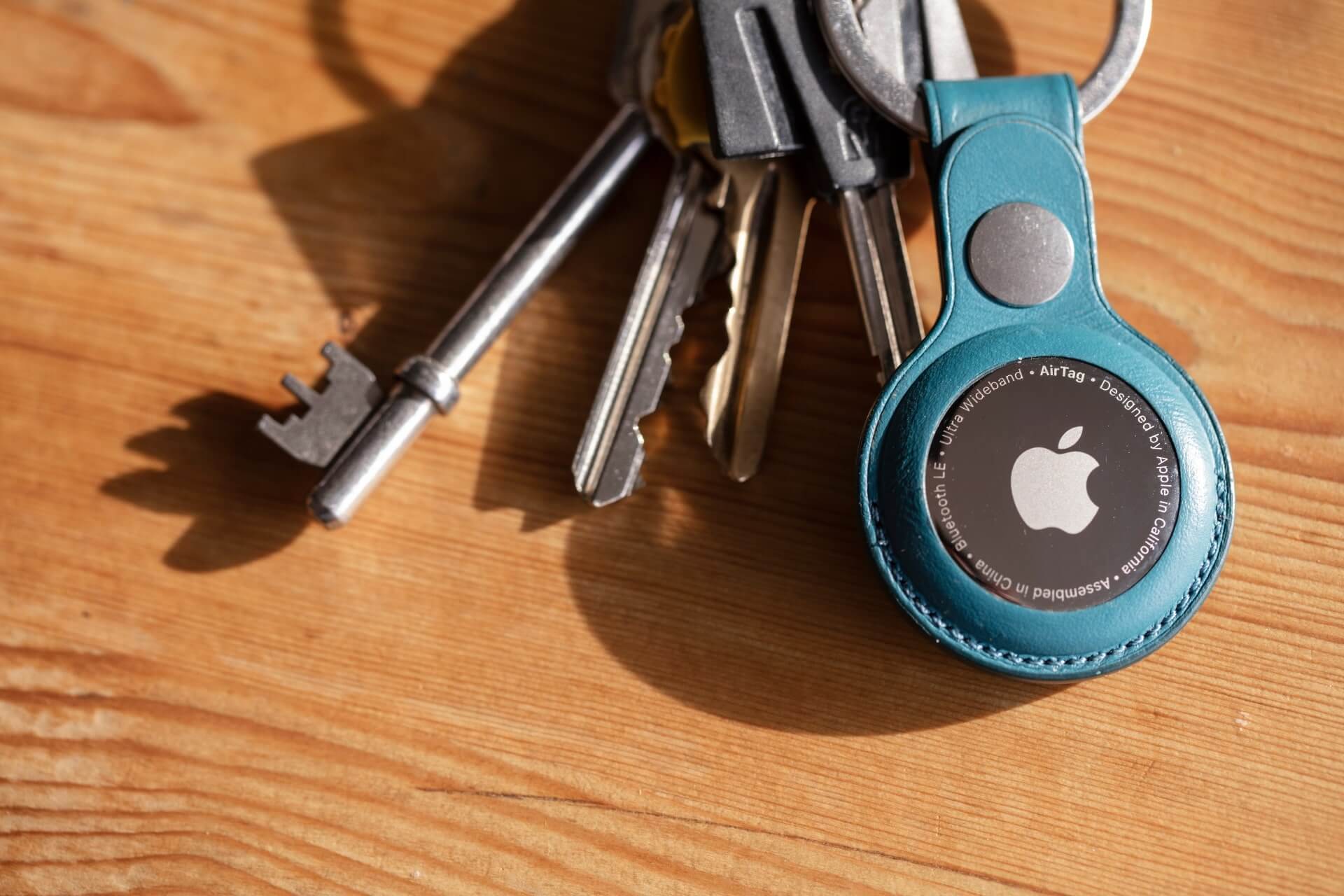
AirTag doesn’t have GPS and can’t track locations on its own. Instead, it uses Bluetooth to connect with nearby Apple devices, which help determine its location.
Finding lost items is what AirTag was made for – and it can do a great job at that if conditions are right (i.e. iPhones are nearby).
But since AirTags rely on Apple’s Find My network, they only update location when near an Apple device. That means that if your dog runs off and is not in immediate proximity of an Apple device, you may not get location updates at all.
Why AirTag is perfect for finding lost items
If you’re an iPhone user, an AirTag in your wallet makes it easy to find. Whether you left it at home or at the grocery store, it’s likely near you or another iPhone user. That’s exactly what AirTag was designed for—quickly locating misplaced items.
Here’s how AirTag helps you find lost items:
- Play a sound on the built-in speaker to locate it nearby.
- Use Precision Finding to get step-by-step directions if it’s close.
- Enable Lost Mode to get a notification when another Apple device detects it.
Simple, effective, and great for wallets—but not for tracking pets.
…but you can’t rely on it to track a runaway dog
Your keys and backpack aren’t going anywhere on their own—but your dog can. And when a dog takes off, they can cover a mile in minutes.
Now, imagine you’re on vacation, and your dog slips out of their leash, chasing a squirrel into the woods. If no Apple devices are nearby, AirTag won’t help. It only updates when your dog comes close to an iPhone again—which might be too late.
For something as important as your pet’s safety, you need real-time GPS tracking—not a lost item finder.
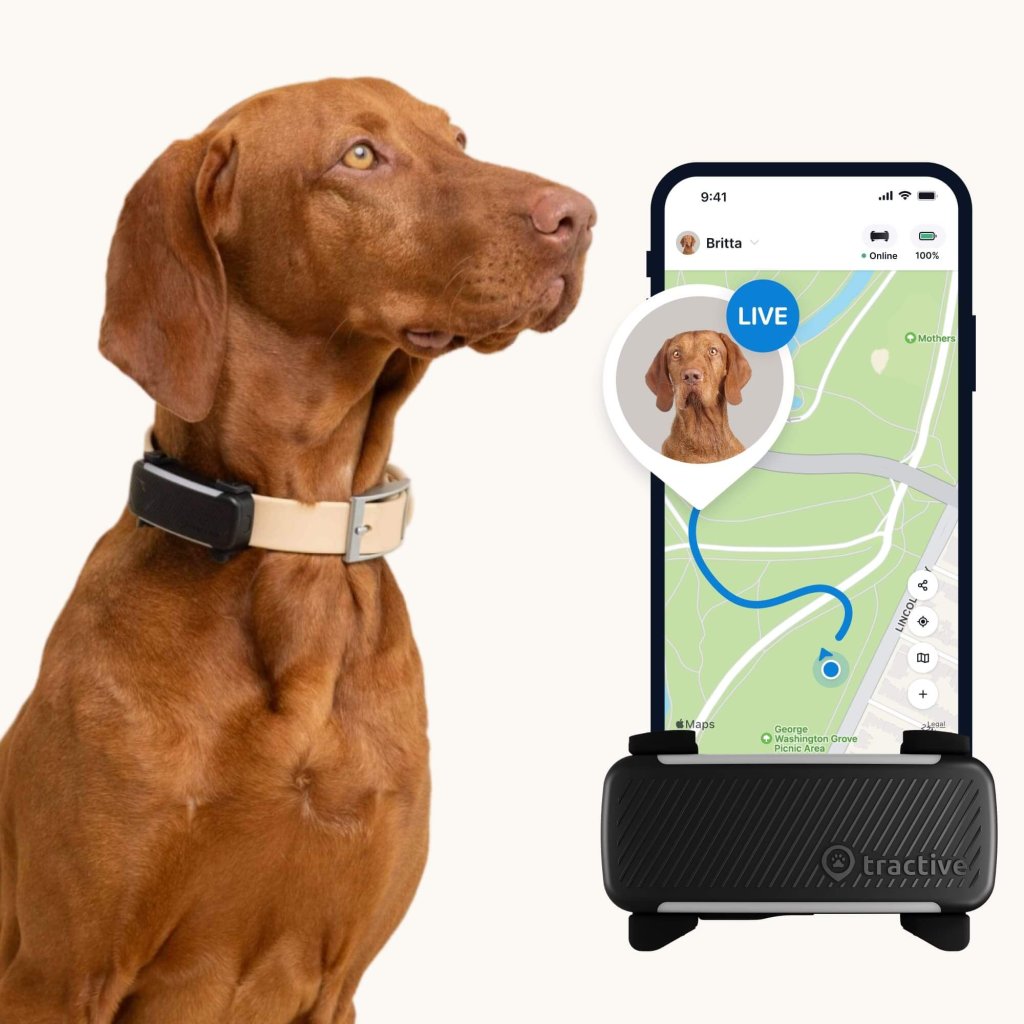
Track your dog with confidence—beyond Bluetooth
- Enjoy real-time GPS tracking with unlimited range, keeping tabs on your dog’s every move.
- Set up safe zones and get instant alerts if they wander off.
- Monitor their activity levels and sleep to ensure they stay healthy and active.
- Receive alerts for early signs of behavior or health changes.
Choose Tractive for true peace of mind, wherever they roam.
The problems with using AirTag for dog tracking
AirTags may work well for finding lost items, but they have major limitations when it comes to tracking pets. Here are the main issues we’ve found with using an AirTag to track your dog:
- No real-time tracking – AirTag only updates when near an iPhone, which means delayed location updates if your dog runs away.
- Limited tracking – If no Apple devices are nearby, you won’t be able to track your dog at all.
- No escape alerts – You won’t be notified if your dog runs off—you’ll only find out when you check manually.
- Not designed for pets – AirTags aren’t waterproof, aren’t chew-proof, and can be a health hazard if swallowed.
For example, in Apple’s Support Community forum, one user writes: “My iPhone won’t pick up my dog’s AirTag when I leave home. Am I doing something wrong?” A whopping 70 other Apple users in that thread alone stated they had the same issue. Unfortunately, many AirTag users discover that it’s not ideal for tracking their dog only after it’s already been put on their pup’s collar — with less than desired results.
In an interview for FastCompany, Kianne Drance, Apple’s VP of iPhone Marketing, stressed that AirTags are meant for tracking items—not people or pets. She also stated that if people use AirTag to track pets, it’s crucial for moving pets to come within range of a device on the Find My network in order to be tracked.
The bottom line: AirTags are built for finding lost items—not for keeping pets safe.
If you were considering using an AirTag to track your dog and are disappointed thus far — fear not. There’s a better alternative out there for tracking your dog, keeping them safe and giving you peace of mind: a GPS dog tracker.
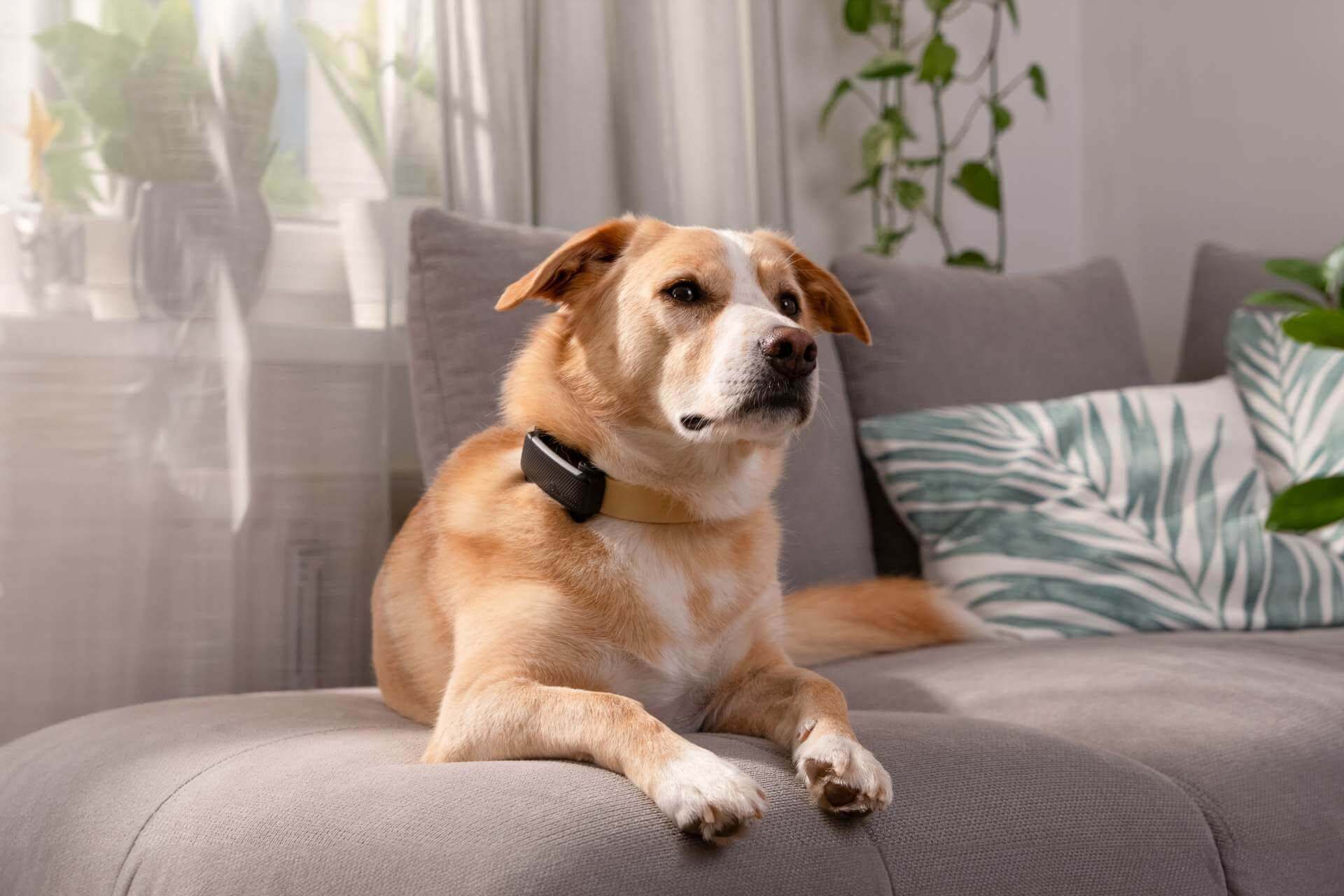
What is a GPS dog tracker?
A GPS dog tracker is a pet-safe device that attaches to your dog’s collar and uses GPS, cellular networks, and a built-in SIM card to provide real-time location tracking. Unlike Bluetooth trackers like AirTag, GPS dog trackers like Tractive generally work anywhere with cellular coverage. They also send instant escape alerts, and often include activity and health monitoring to help keep your dog safe and healthy.
Top reasons to choose a GPS dog tracker like Tractive over AirTag for dogs
Real-time GPS tracking ensures you can find your runaway dog fast
The whole point of tracking your dog is to ensure you can find them when it truly matters. If your dog runs away or is in danger, you don’t want to rely on others for location updates—you need instant, real-time tracking at your fingertips.
With Tractive, you can see your dog’s live location on your phone, with updates every 2–3 seconds in Live Mode. This means you’re not just finding a lost dog faster—you’re preventing them from getting lost in the first place.
Unlimited range tracking = peace of mind
When it comes to tracking your furry friend, range and coverage are everything. A tracker is only useful if it works wherever your dog goes—whether that’s the backyard, a remote hiking trail, or miles away from home.
Tractive GPS & Health Trackers for dogs offer unlimited range by using a built-in GPS and integrated SIM card to connect to cellular networks worldwide. This means no matter how far your dog roams, you can simply open the app and see their exact location in real time—anywhere, anytime.
Escape alerts help prevent lost dogs
Wouldn’t it be better to know your dog is escaping before they’re lost? With Tractive’s Virtual Fence, you can set up safe zones like your home or backyard. If your dog wanders too far or escapes, you’ll get an instant alert—giving you the chance to react before they get too far.
Built for pets: durable, waterproof & secure
Dogs love adventure, which means their tracker needs to be able to keep up. Tractive GPS Dog Trackers are designed for active pets, featuring:
- Waterproof & adventure-proof design—perfect for swimming, rolling in mud, or running through the rain.
- Secure collar attachment to ensure it stays in place.
- Bite-proof casing (on select models) to withstand even the most curious chewers.
Unlike small item trackers, Tractive is built to handle everything your dog throws at it.
Health & Activity Tracking help keep your dog fit & healthy
A GPS dog tracker isn’t just about location—it’s also about your dog’s well-being. Tractive helps you:
- Track daily activity & rest to ensure your dog stays healthy.
- Spot early signs of health issues by monitoring sudden changes in movement.
- Set fitness goals to keep your dog in shape.
With Tractive, you’re not just keeping tabs on your dog—you’re helping them live a longer, healthier life.
(Bonus) And so much more
Besides all that we mentioned above, there are so many more reasons to choose a dedicated GPS dog tracker like Tractive over a simple item finder like AirTag. Tractive dog trackers are being continuously developed and optimized to best serve you and your furry friends. So here are a few extra features you can look forward to:
- Location History
- Separation Anxiety Monitor
- Bark Monitoring
- Walks
Real Stories: Why dog parents switch from AirTag to Tractive GPS
As the makers of the popular Tractive GPS & Health Tracker for dogs, we often hear from pet parents around the world why they made the switch from another tracking device to Tractive. Here are three such testimonials – folks like you who thought AirTag would work to track their dog, but found Tractive to be a much better choice.
1) “Couldn’t walk my Husky without Tractive”
“My Husky can set off really fast – without Tractive I would never be able to find him. I use the live feature as it updates constantly. Previously I used an AirTag, however it never had a signal in the forest. Now, with Tractive, I can track wherever he is when we are both exploring together.”
2) “I can see exactly where she is anytime”
“I ABSOLUTELY LOVE THIS!! I had originally purchased an AirTag that didn’t show me where my dog was once I left my house (beyond pointless). With Tractive I can see exactly where she is anytime that I want, from anywhere that I go. We also have a creek that she loves to swim in and it’s 100% waterproof. I charge it maybe once a week while she’s sleeping. It gives me such a peace of mind. She’s also very rough on her collars and anything on the collars. And it has some scratches but still works and it stays on her collar. I highly recommend this product!!”
3) “We can always find our adventurous Golden Retriever”
“Our adventurous Golden Retriever Oliver is allowed to roam our 20 acres, but we were worried about him roaming too far. We tried an Airtag first, but it has to be near an Apple product to be effective, so that didn’t work. So we tried Tractive and it works awesome! In the app we can see exactly where Oliver is anywhere on our property. And the crazy thing is, most cell networks don’t work very well in our area, but Tractive still works all the time. We are so happy with this product.”
The right dog tracker can save your dog’s life
It’s our responsibility as pet parents to keep our canine family members safe. And nowadays, there are plenty of ways to keep your dog healthy and happy. From regular vet visits to the right diet and gear, from healthy routines to the perfect home environment. But did you know that equipping your dog with the right tech – namely a reliable GPS dog tracker like Tractive – could literally save your dog’s life? Here are a few stories that prove just that: 10 Dogs Whose Lives Were Saved By Tractive
The bottom line on using AirTags for dogs
Unlike AirTags, which are designed for tracking objects—not pets—a GPS dog tracker like Tractive is purpose-built for your dog’s safety, offering real-time location tracking, escape alerts, health and activity monitoring, and durability that can keep up with any adventure. When it comes to protecting your best friend, only a dedicated GPS tracker gives you the peace of mind you deserve.
FAQs: AirTag for dogs
What are the pros and cons of using AirTag for dog tracking?
Most people are drawn to the idea of using Apple AirTag for dog tracking because they’re 1) small & lightweight, 2) cheap and 3) have a long battery life. But in addition to the pros, AirTags have some important downsides you need to consider before you put one on your dog’s collar:
Pros
- Easy to use
- Small & lightweight
- Long battery life (up to 1 year)
- Works great in areas where Apple users are nearby
- Affordable at only $29
- Free personalization
Cons
- No GPS live tracking
- Swallow hazard for your dog
- Won’t work out of bluetooth range of an Apple device
- Not designed for tracking pets
- No pet-friendly features, like Virtual Fences or Health Alerts
How does AirTag work for dogs?
If you were to try AirTag for dog tracking, here’s how that would work:
- Buy an AirTag and connect it to your Apple device.
- Attach the AirTag to your dog’s collar or harness.
- AirTag sends out a signal that gets picked up by Apple devices within range. They send their location along with the AirTag’s identifying data to Apple servers.
- When you need to locate your dog, you can open the Find My app and (in the best case scenario) view your dog’s location.
- If necessary, you can “Ping” the AirTag – it will make a sound that helps you find it.
Keep in mind, AirTags aren’t pet trackers. So don’t expect them to work in the same way a dedicated GPS dog tracker would. Meaning you’ll miss out on the ability to track your dog in real-time no matter how far they roam. And if your dog runs out of range of an iPhone, you may not be able to find them with AirTag.
In that case, you can activate “Lost Mode” – you’ll get a notification when your dog is back within range of another Apple user. Then other people can tap the AirTag to see your contact information and get in touch with you.
If your dog is likely to escape or roam in areas with no Apple users nearby, tracking them with AirTag is not a reliable option.
